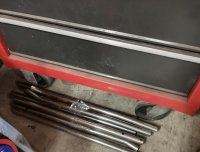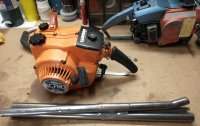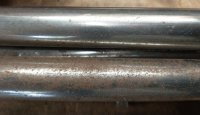cus_deluxe
terms of service violator
- Local time
- 9:19 AM
- User ID
- 393
- Joined
- Jan 3, 2016
- Messages
- 5,195
- Reaction score
- 24,221
- Location
- Michigan
sweeeet!
Going to get broken in with several heat cycles on some mineral or blend oil. Then driven gentle on the same oil mix for a tank. Then Dominator at 25:1 and Sunoco Optima 95.sweeeet!
Here's what I'm building now.
View attachment 294000 View attachment 294001 View attachment 294002 View attachment 294003
About the cheapest quality gas RC is around $900 ready to run. Comes built with radio gear and everything. You just ad mix, batteries for the transmitter and charge the battery for the on car electronics. The car pictured is not a beginner car unless you are reasonably mechanical and have some prior experience choosing components and setting up everything. My car comes with nothing but the car. Not painted, nothing assembled. I had to choose a what radio gear, servos, engine, pipe ect. I'm close to the cost of two stock 500i saws now. Eventually I'll be upgrading the engine to a full race ported 9.4 horsepower monster which adds another sizable chunk of change.Just curious. What's it cost to get into something like that? A solid 2 smoke RC car? And how does one know what is quality and what is junk?
I have some grandsons that need a hobby that gets them away from the Xbox.
Feel free to PM me if you don't want to discuss $$ in an open setting.
Keep in mind, I'm putting a host of upgraded parts in the car as I build it which is adding to the cost. Id rather have them in from the start vs fixing it later.
Yes sir.Understood. Thanks for the info.
Damn that’s some nice looking guts. Ain’t no way that’s a budget piece.Here's what I'm building now.
View attachment 294000 View attachment 294001 View attachment 294002 View attachment 294003
Funny you mention the rust deal. I just recently concluded two rust tests. One was a year long with 6 different oils, full synthetic, blends and a full mineral. I smeared each on clean bare steel and let set uncovered in my uninsulated, unheated, garage where the floor sweats in summer from the humidity and we often are below zero in winter. Guys in the oil PM were there for this. None caused / allowed any rust to form. Fuel was not involved.Damn that’s some nice looking guts. Ain’t no way that’s a budget piece.
Another oil thread...
To sum up what I’ve learned from the many, synthetics protect moving parts better and fossil oil protects against rusting/oxidation betterer. Any oil can burn, synthetic or otherwise-depends on the situation as Kev says above. The synthetics that don’t usually burn leave some rock hard residue in most cases when they do burn.
Always wondered why Echo RA was a blend, now I know why.
Did you have a clean not oiled control in each test?Funny you mention the rust deal. I just recently concluded two rust tests. One was a year long with 6 different oils, full synthetic, blends and a full mineral. I smeared each on clean bare steel and let set uncovered in my uninsulated, unheated, garage where the floor sweats in summer from the humidity and we often are below zero in winter. Guys in the oil PM were there for this. None caused / allowed any rust to form. Fuel was not involved.
Next, also recently completed was a test on Dominator. I ran two string trimmers on 40:1 mix. One was VP 94 the other E-free pump 90 octane. They were put away in the same garage last fall at the end of the season and taken back out a few weeks ago. Normal homeowner type storage. Not ran all winter. One trimmer was hung so oil would drain away from the internals to the crankcase cover, the other stored engine up so oil stayed on the internals. No rust on either or any other corrosion and the one hanging still had red oil on all the internals despite being hung up. But wait.... there's more.
I have a crankshaft that I slathered in Dominator and placed it in a Ziploc open just enough to allow air in / out. Also the same garage. That will be a year in 9 more days. Still shiny. Why the special Dominator tests? Because Dominator causes rust don't ya know. Says so on the bottle. Lol. It why you can't run it in outboards "they" say. Outboards and rust are not the reason Amsoil has the disclaimer. Its about using a non TCW3 oil in an outboard. Dominator does say NOT to use with fuels containing alcohol. I'm sure alcohol / oxygenated fuels are the reason for most engine corrosion no matter the oil.
The last test currently happening may be of most interest to you. This came about from a discussion in my oil PM similar to your statement about mineral oils protect better from rust. I've never had rust / corrosion with any oil I've used, mineral, blend or full synthetic, so I have zero input other than my own experience and the above outlined experiments. My equipment also never sets a year unran. I'll fog it if that would be the case. Anyway, that's where this last test comes in. I took 12 mason jars and six oils. Two each of full synthetic, blend and mineral. I mixed each oil with E-free pump and 87 10% ethanol pump fuel. So each oil mix is in jars, one with ethanol, one without. In each jar is a piece of bare steel, magnesium and aluminum. These jars are capped with a small vent hole. This test will go till complete evaporation has occurred. I look forward to the results.
In a nut shell, for me, in my area, I have zero concerns about engine internals rusting. Someone in the deep south might have different issues. View attachment 294066
Did you have a clean not oiled control in each test?
Could much of the rust in engines form while they are running? A burn barrel takes many years to rust thouroghly if nothing is ever burned, but a frequently used barrel will turn to dust in less than a year.
Here ya go bud. These scrap steel tubes were laid in that spot late summer last year. They came from my wife's work. They even had whatever oil was on them from the manufacturering process. I just took these now. This is in the drier rear garage where cars aren't dragging road salt in all winter which greatly contributes to the front garage sweating in the humidity. That's where the rust test took place. In that salty garage.Did you have a clean not oiled control in each test?
Could much of the rust in engines form while they are running? A burn barrel takes many years to rust thouroghly if nothing is ever burned, but a frequently used barrel will turn to dust in less than a year.
Heat accelerates rust formation.





I'm a more oil is better guy and that's never going to change. It's been proven many times in dyno testing that more oil is more power up to 15-18:1. The engines were cleaner inside with more oil as well. Plugs were dirtier. Obviously in OPE with fixed jets or M-tronic / Autotune there will be a limit where the jets can't keep up with the added amount of oil. Where that is depends on each engine / carb combo. Smaller engines seem to hit that point of diminishing returns faster on the power aspect. RPM plays a role. I was big into the 1/5 scale rc and am now getting back into it. Those engines stock put out way more HP per cc than any stock saw and many woods ported saws. Stock they turn nearly 20,000 RPM unloaded. Manufacturer recommended ratio is 25:1. You can rest assured my new car will be ran at that ratio. The other thing I've said before in the open oil thread, I've never seen someone say "I blew up my 2 stroke engine from running to much oil".In the interests of the thread. We know ethanol in fuel will attract moisture from the air, if you live in a humid environment, or your saws go cold to hot environments then you will get condensation. so the thing I believe if the oil is sticking to the surfaces of the engine and it can repel water that is being attracted the the ethanol in you fuel then it’s a winner.
I’m wondering if the bearings are a weak spot in the engine as they are steel. This could be where running 40:1 is better than 50:1. Ie more oil left in the engine bearings and less chance of rust.
You could add this to the analogy to the rings as well. But I add oil to the cylinder if I,m storing a saw for a while. I,m still not not sure about what oil is left after combustion. Maybe it’s what ever is still below the rings.
This also reminds me of a couple trimmers I had here as potential test units. Ethanol fuel mix had been left in them. The crankcase bottom was almost eaten through on them. No idea how long it took but there was still oil residue in them along with a nasty white crust and deep pitting in the crankcase. Some light rust on the main bearing and rod. I'll never run fuel with any type of alcohol unless an absolute emergency. E-free pump is everywhere by me now. 5 miles away is the closest and 17 the farthest. There are at least 6 stations in that range selling 90 octane recreational E-free fuel. I feel bad for folks having to drive 50 miles or more to find it.In the interests of the thread. We know ethanol in fuel will attract moisture from the air, if you live in a humid environment, or your saws go cold to hot environments then you will get condensation. so the thing I believe if the oil is sticking to the surfaces of the engine and it can repel water that is being attracted the the ethanol in you fuel then it’s a winner.
I’m wondering if the bearings are a weak spot in the engine as they are steel. This could be where running 40:1 is better than 50:1. Ie more oil left in the engine bearings and less chance of rust.
You could add this to the analogy to the rings as well. But I add oil to the cylinder if I,m storing a saw for a while. I,m still not not sure about what oil is left after combustion. Maybe it’s what ever is still below the rings.





